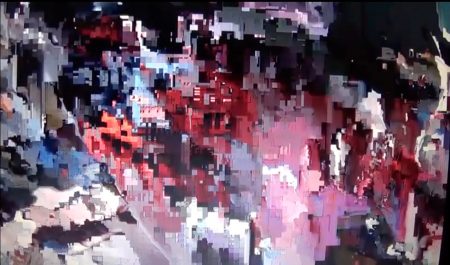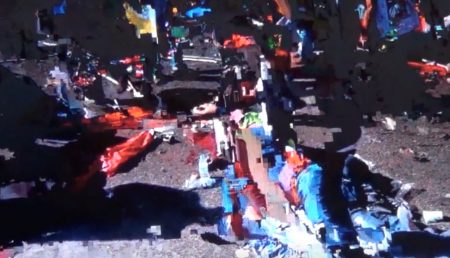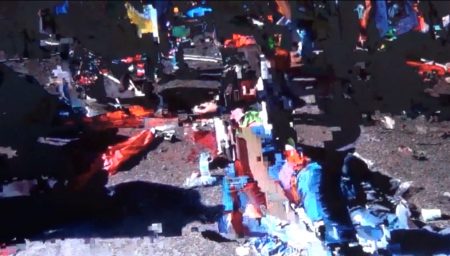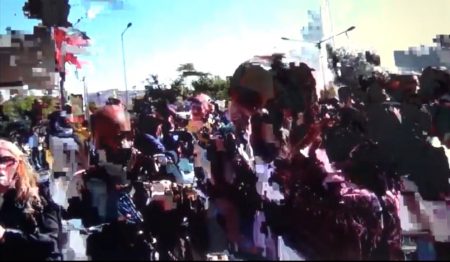In my home country, Turkey, the amorphous term “terrorist” has adopted folk-lore speculative projections: from a baklava magnate to journalist dissenters and high school teachers, from professors to artists, the unpredictability of being labeled a “terrorist” blankets all such dissenters who dare problematize the ruling AK Party/President Erdoğan. One such case is that of Oktay Ince, a video activist/filmmaker whose work, spanning the last twenty years, was recently confiscated by Turkish authorities after being taken into police custody on May 30, 2019. Ince had raised suspicions after attempting to organize a protest in front of a courthouse in the capital of Ankara; he was quickly arrested. Similarly, a month prior, Ince had organized a protest in Izmir and was arrested once again, labelled a “terrorist” and charged with “insulting the president.” The state’s response soon began to appear pathological.
Over the last year, I have grown reticent towards many of my artist peers’ endeavors. Disconcerted over the state of contemporary artists (within my own social circle in New York/Brooklyn) eagerly steeped in what they term “political art”—with work often amounting to little more than hackneyed slogans and appropriative rephotography techniques depicting Trump and company as bumbling “alt-right” fools—I recently prodded the question “what does art look like when it attempts to philosophize?”[1] The dismayed conclusion I reached was that it does not look terribly alluring; so very often, it is Gilles Deleuze, Michel Foucault, Jacques Derrida or poststructuralist feminists such as Judith Butler, Gayatri Spivak or Luce Irigaray whose works are misappropriated, their literature reduced into mere apothegms: e.g. “multiplicity,” “power,” or “doubling/différance”; “performed gender,” “subaltern,” “the feminine” (in respective order), stripping these theorists of their constitutive complexity and philosophical rigor.[2] Nonetheless, as I muse over politically galvanized contemporary Middle Eastern artists, poets and writers, so many of whom write from a place of disquietude and uncertainty—drawing from the induced mania teeming within the stiff echoes and quiet shrills that reverberate within a prison cell, where plucking a poem is an act of insurgency—I am reminded that a work of art can still wield equipollent political promise. It is, in fact, not the work, itself, but so very often the conditions from which the work transpires that determine its palpable pulse.
Oktay Ince’s video art is truly alien to American audiences: never have these films been the subject of a permanent or rotating exhibition nor featured in screenings; instead, they have been relegated to the annals of the virtual and, seemingly, even then been banished from the circuits of the internet. Indeed, a Google search of “Oktay Ince Vimeo” only produces another videographer’s music videos and, aside from Oktay Ince’s Youtube channel, it is rather difficult to find his work. Thankfully, however, video artist Belit Sağ—a fellow video artist based in Amsterdam, who has worked with a number of video activist collectives in Turkey—screened three of Ince’s films at Interference Archive, a Brooklyn-based volunteer-run library and archive, which features historical materials related to social and political movements (a venue I highly extol and recommend for all New Yorkers interested in leftist historiography).
The first of these three videos, “Anaların Öfkesi” (“The Peace Mothers’ Rage”), is demonstratively pedagogical, recalling something of the early 1970s’ structuralist Marxism, as a band of activist mothers in Ankara (known as the “Peace Mothers”) show solidarity in protesting the death of thirty-eight political prisoners. This protest was held as a memorial for the eve of the Hayata Dönüş Operasyonu (Return to Life Operation), which saw the pinnacle of a three-month prisoners’ hunger strike (in resisting inhumane isolation practices in high security “F-type prisons”); on the evening of December 19, 2000, thirty-two prisoners were killed by prison guards.
In a separate video, a camera, tracing protesters in Istanbul, negotiates between scenes of ordinary women and men jeering slogans of solidarity while booming, in unison, against mass detainment and curbed freedoms of expression. Adopting a documentarian mode, Ince’s camera recollects a festering throng of riot gear-clad police members, burgeoning and swarming in a collective Stygian horde, their batons crackling over the backs of protestors who collapse, melding with the cement. Shield-wielding riot police then drag these unconscious and half-conscious bodies as protestors stream through the streets, folding between the police like the threads of a shallow stream. From a set of balconies we can make out a string of anti-IMF (International Monetary Fund) banners, as collective chants flourish. The camera focuses on hands and rocks, an object study of sorts. Soon, Ince’s seeping tracking shots of heavy bodies being lugged across the pavement produces faint splotches of yellow and white, which smear across the screen, as if these bodies were not only dragged but the pixels upon which they are reproduced are, in turn, swollen, distended and heavy, smearing the screen-surface.
In addition to his video activism, Oktay Ince is an essayist. In an essay titled “The Law and the Image: The Camera as an Objective Wtiness, ‘It does not lie,'” Ince argues that, because the machine that visually records an event “is inanimate,” the image is, therefore, “[t]he track of reality, a copy as the same of reality.” Accordingly, the camera proffers a simulacra-testimony more credible than “a human being, who can say anything out of fear, or who may accept a bribe, or want to bestow a privilege upon someone. Now the expression by a witness has been gaining credible quality only after the verification by camera.”
This position will, of course, be familiar to those who recall that 1970s film theory—from the “apparatus theories” of Screen to Laura Mulvey and Christina Metz’ psychoanalytic readings—tendered that it was the duty of theory to resolve ideology, and that cinema could serve as an extensive apparatus. This cultural episteme is also indexed by an accompanying philosophical moment of Marxist structuralism. Recall that, of the subject of a work of art, it was Althusser who tended towards abolition, reducing that which is aesthetic into a “simple epiphenomena of structure.”[3] As such, aesthetic action develops a mark of social agentialism rather than the mere carrying out of a rule; accordingly, a kind of “theoretical anti-humanism” accompanies the argument that philosophy/theory is productive, producing an image of the Real. Just an Oktay Ince asserts that the camera-eye (kino-eye) facilitates access to an otherwise overdetermined field of political life, Marxists such as Althusser vied for a kind of structuralist causality, symptomatically read through a philosophy of praxis, on the hope that the Real can be transformed by thought.[4] Much like Ince, media theorist Fredrich Kittler’s “hardware realism” contended that the audio recording of a tape allowed for access to the Real (that “there is no software”).
Nonetheless, today we recognize that technological apparatuses are mediated and engaged in pathologically distorted techniques—from the very first media artifact one encounters, they undergo a kind of existential modulation: take, for instance, the mirror stage (the first moment of autonoesis, where one recognizes their self-image as autonomous from the mother), which Lacan associated with castration. Here, is not “extension” into the Real but, instead, a performative interplay between artifact and artifice that one participates in. Nonetheless, Oktay Ince’s primary interest is in how cinema thinks through evidence: according to the sonic content, the “cut,” or editing:
“[t]he image, at the same time, leads to a public inspection of the decisions by the court that makes judgments on behalf of the people, because the image can convince large audiences that it reaches and can transform all of them into witnesses. A person who was watching the images of how Ethem Sarısülük was shot by a police officer, or a person who is listening to the phone call between Erdoğan and his son about laundering the money obtained through bribery, cannot accept an acquittal or release decision by the court on their conscience. The legitimacy of court decisions becomes questionable.”[5]
As such the image and sonorific bricolage, understood as a material relic and echo, is posed as an empty signifier of the “analog recording device” as a central nexus. Oktay Ince’s ontological argument is that the image has an existence independent from us, it confers reality that is superior to the human account of a interpellator. Thus, in order to properly instrumentalize the montage, Oktay Ince’s filmmaking practice is one of archiving, itself: from CNN “Turk TV” cameras to state-controlled Mobese cameras changing their direction in correspondence to their field of vision, Ince is interested in the montage of recorded realities as an informatic proof (rather than as the vitalist reproduction of time in a pure durational state).
Thus, in his second film “Dijital Kirilmalar” (“Digital Breakages”), which happens to be my favorite, we see how digital interpellation can appropriate the biometric practice of control vis-a-vis sousveillance (which transmogrifies State surveillance).[6] The practice of “datamoshing,” which Ince here employs, is the process of manipulating data in media files so as to achieve visual or auditory effects; when the files is decoded, decomposing its varied intervals, the “datamoshed” image produces digital chaos from complexity, glitches probing and bending its terrain of reference. In Ince’s “Dijital Kirilmalar,” faces becomes pixelated, frames are frozen into variegated pointillist streaks. The abstracted bodies and faces of protestors blend into deliquescence; when asked about this technique, Ince gives a rather technical answer: “[t]his is to conceal the protestors’ identities.”
Oktay Ince’s interest is primarily in how an image mediates crime and violence, retaining affect as an authoritative operant signifier, while deposing of the violent end that surveillance areas have led to the formation of new crimes areas and new crime definitions and how sousveillance can be an appropriative activity of the people’s reclamation:
“In 2005, the state was caught red-handed by a mobile phone camera in Şemdinli. In 2007, we watched the last unofficial fascist gunmen of the state, the murderer of Hrant Dink, from the Mobese cameras. After the murderers of Ali İsmail and Ethem Sarısülük were caught on cameras during the 2013 June resistance, the state found itself in a position in which they were not able to cover their dirty wars and murders because of these monitoring networks. When they could not hide their killers from the public and could not avoid trial, they took the murder monopoly into their own hands from the counterguerrillas, and removed all the limits on the warrants of armed forces to kill. They started to commit murders in front of live cameras, and they did it legally. The government no longer needed to remain as an “unknown perpetrator” while committing a murder as it happened in the 1990’s.”[7]
Oktay Ince’s work further examines how surveillance areas have led to the formation of “new crimes areas” and “new crime definitions,” probing how sousveillance can be an appropriative activity of the people’s reclamation. In the third, and final, video—“Yüksel Direnişinin,” or “Flourishing Resistance”—Oktay Ince documents Nuriye Gulmen and Semih Ozakca, a literature professor and primary school teacher, respectively, who have lost their jobs during mas lay-offs following. Spreading disinformation, the court accused Gulmen of staging the hunger strike on the orders of the Marxist-Leninist DHKP-C group, which is classed as a terrorist organization in Turkey. The two teachers, how have both vehemently denied this attempt to thwart their highly personal battle, continued to convene in a a central Ankara square, at times drawing others to protest this government purge, which cost both themselves and tens of thousands of other Turkish denizens their jobs and livelihoods. “We have lost weight, our pulse and blood pressure has dropped, we have problems walking and we are exhausted,” Gulmen told Reuters at the square.[8] As Ince’s documentation demonstrates, police almost always appear to either subdue the protest and, when unsuccessful, detain/arrest the protestors (with each consequent protest, the police appears with increasing haste). Gulmen and Ozakca’s bodies are presented in a compromised state; as they continue to protest, they don surgical masks to reduce the risk of infection.
This primarly culls a historical practice: from hunger strikes at Diyarbakir Prison after the coup d’etat of September 12, 1980 to the hunger strikes of political convicts and Kurdish hunger strikers at Silivri, Şakran and Tekirdağ prisons, in Turkey the hunger strike has been used as a means to reach political concessions through non-violent processes. The immunologically compromised bodies of these two strikers, whose ideational vigor is metaphorically distorted by the hands of the State and physical bodies are manipulated by police repondents, colors a wider theme that further traverses Ince’s work.
In the second film, by visually reproducing the discordance and cacophany, this work–silenced as it is (it is, in fact, mute)–evokes the disruption of the on-screen sensorium. These unsanitized channels of enunciated counterfactuals evoke those “inventories” that Michel Serres remarks upon as communicative pathogens: “stammerings, mispronunciations, regional accents, dysphonias … cacophonies … background noise, jamming, static, cut-offs, hysteresis,”[9] reproducing noise as graphic form via collage. It is the collage-cum-montage, the impulse of editing through which cinema thinks, that Ince begins exploring with the bleeding tracking shot in the first film and finds as an inflamed motif with the second work. As an archivist of the montage, Ince’s engagement with the irreducible is not simply technical but syntactical, engaged with bodily breakdowns. In the and first and second work, alike, it is the body that is corrupted digitally and, in the third, immunologically.
In the third example we have a particular curious case: as Donna Haraway reminds us in Cyborg Manifesto, “women make special antibodies that musk the tell-tale foreign signals on the foetal trophoblasts, so that the mother’s immune surveillance system remains blind to the foetus’s presence. By immunizing the ‘rejecting’ women with cells taken from their ‘husbands’ or other genetically unrelated donors, the women’s immune systems can be induced to make blocking antibodies.”[10] In the hunger strike, those immunizing antibodies are corrupted by the anti-evolutionary process of asceticism, with the inversion of pregnancy made manifest in the desolate state of these instructors who have been disrobed of any “surplus-value” and remains extraneous, engorged. Seen as disposable by the state apparatus, these protesers are made themselves foreign (thus, labelled “terrorists”)—susceptible to illness, susceptible to the hands and gestural bent of responding riot police and susceptible to the whims of a fractured legislative bridleway.
In the Turkish state’s purview, the “terrorist” occupies the epitomal position of the generic and extraneous, outpouched by language and outmoded to the peripheries of the State’s informational apparatus—these are not images that seep into the collective mediascape of Turkish entertainment or news. In turn, it is the “terrorist,” recollected and exchanged ad infintum, that is nonproductive, rather than that which is violent and implosive. Similarly, Ince’s video art demonstrates the politics of contaminated commodity consumption, the cacography of the immunologically and economically compromised denizen who remains as a phobic toxicity to the State infrastructure. Foreclosed interlocution, ex-communicated and inadmissible, the Turkish state has relied on donning the diagnostic mask, a false prosopopeia of phobogenetic means intended to demonize the protester who dares become an obtrusive absentee. Through his video art, Oktay Ince reclaims this enigmatic, haunting presence of protest, the sensibilities of that which is made errant by the state; Ince amplifies this via the unreturnable regard of reticulated camera-eyes: cell phone lenses, CCTV and news sources, mapping an arachnean latticework, with projecting linealities that point towards a horizon of political becoming. As Oktay Ince spearheads a fight to regain his archive, I am reminded of the political prowess that art, exclusively, can situate.
–Ekin Erkan
[1] Ekin Erkan, “On a Certain Tendency of Contemporary Installation Art”, AEQAI (Winter 2019)
[2] A curious consideration—analytic philosophy does not have this problem! It is a plague upon the Continental tradition.
[3] Pierre Bourdieu, The Field of Cultural Production (New York: Columbia University Press, 1993), 269.
[4] For more on Althusser’s structuralist causality and its Spinozist pollination, see Jonathan Fardy, Althusser and Art: Political and Aesthetic Theory (UK: Zero Books, 2020).
[5] Oktay Ince, Autonomous Archiving, ed. Artikisler Collective (Özge Çelikaslan, Alper Sen, Pelin Tan) (Barcelona: DPR, 2016), 58.
[6] As opposed to surveillance, “sousveillance” “a look from/of the outside that has now entered the interior as an uninvited guest,” the “unreturnable regard that is everywhere and nowhere.” Souveillance is a recording from within, generally by a participant with a portable device (usually by cell phone but, sometimes, by camera) rather than from the State. See Allen Feldman “Incivilities of Sound and Sense: Rumor as Cacographic Violence and Internal War” Object Series (May 2019). On “sousveillance” in the context of American protest, see Nicholas Mirzoeff, The Appearance of Black Lives Matter (NAME Publications: 2017) and Nicholas Mirzoeff, The Right to Look: A Counterhistory of Visuality (Durham, NC: Duke University Press, 2011).
[7] Oktay Ince, Autonomous Archiving, 61.
[8] Ece Toksabay, “Weakened but defiant, Turkish hunger strikers protest purge” Reuters World News (May 11, 2017).
[9] Michel Serres, Hermes: Literature, Science, Philosophy (Baltimore: John Hopkins University Press, 1983).
[10] Donna Haraway, Cyborg Manifesto (Routeledge: New York, 1991), 139.









